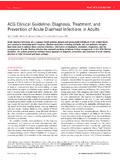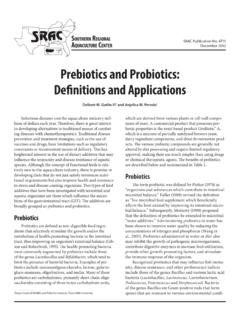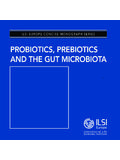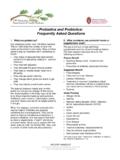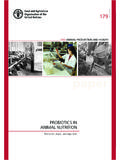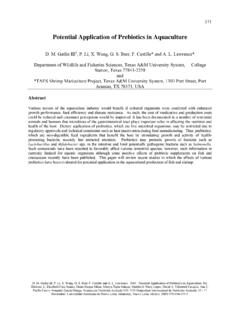Transcription of Probiotics and prebiotics - Sociedade Portuguesa …
1 World Gastroenterology Organisation Global Guidelines Probiotics and prebiotics October 2011 Review Team Francisco Guarner (Chair, Spain) Aamir G. Khan (Pakistan) James Garisch (South Africa) Rami Eliakim (Israel) Alfred Gangl (Austria) Alan Thomson (Canada) Justus Krabshuis (France) Ton Lemair (The Netherlands) Invited outside experts Pedro Kaufmann (Uruguay) Juan Andres de Paula (Argentina) Richard Fedorak (Canada) Fergus Shanahan (Ireland) Mary Ellen Sanders (USA) Hania Szajewska (Poland) Ramakrishna (India) Tarkan Karakan (Turkey) Nayoung Kim (South Korea)
2 WGO Global Guideline Probiotics and prebiotics 2 World Gastroenterology Organisation, 2011 Contents 1 Probiotics the concept 3 2 Products, health claims, and commerce 6 3 Probiotics the science 12 4 Clinical applications 14 5 Probiotics , prebiotics and evidence the global picture 17 List of tables Table 1 Definitions used by the international scientific associations for Probiotics and prebiotics 3 Table 2 Definitions 4 Table 3 Nomenclature for microorganisms 6 Table 4 Examples of probiotic strains in products 7 Table 5 Information on suppliers of Probiotics and prebiotics 9 Table 6 Human intestinal microbiota.
3 The gut microbiota form a diverse and dynamic ecosystem, including bacteria, Archaea, and Eukarya that have adapted to live on the intestinal mucosal surface or within the gut lumen 12 Table 7 Mechanisms of probiotic/host interaction. Symbiosis between microbiota and the host can be optimized by pharmacological or nutritional interventions in the gut microbial ecosystem using Probiotics or prebiotics 13 Table 8 Evidence-based pediatric indications for Probiotics and prebiotics in gastroenterology 18 Table 9 Evidence-based adult indications for Probiotics and prebiotics in gastroenterology 21 List of figures Fig.
4 1 Electron micrograph of Lactobacillus salivarius 118 adhering to Caco-2 cells 4 Fig. 2 Spectrum of interventions that can affect health and disease 6 Fig. 3 The normal microbiota and Probiotics interact with the host in metabolic activities and immune function and prevent colonization of opportunistic and pathogenic microorganisms 14 WGO Global Guideline Probiotics and prebiotics 3 World Gastroenterology Organisation, 2011 1 Probiotics the concept History and definitions A century ago, Elie Metchnikoff (a Russian scientist, Nobel laureate, and professor at the Pasteur Institute in Paris) postulated that lactic acid bacteria (LAB)
5 Offered health benefits capable of promoting longevity. He suggested that intestinal auto- intoxication and the resultant aging could be suppressed by modifying the gut microbiota and replacing proteolytic microbes such as Clostridium which produce toxic substances including phenols, indoles, and ammonia from the digestion of proteins with useful microbes. He developed a diet with milk fermented with the bacterium he called Bulgarian bacillus. In 1917, before Sir Alexander Fleming s discovery of penicillin, the German professor Alfred Nissle isolated a nonpathogenic strain of Escherichia coli from the feces of a First World War soldier who did not develop enterocolitis during a severe outbreak of shigellosis.
6 Disorders of the intestinal tract were frequently treated with viable nonpathogenic bacteria to change or replace the intestinal microbiota. The Escherichia coli strain Nissle 1917 is one of the few examples of a non-LAB probiotic. A Bifidobacterium was first isolated by Henry Tissier (of the Pasteur Institute) from a breast-fed infant, and he named the bacterium Bacillus bifidus communis. Tissier claimed that bifidobacteria would displace the proteolytic bacteria that cause diarrhea and recommended the administration of bifidobacteria to infants suffering from this symptom.
7 The term Probiotics was first introduced in 1965 by Lilly and Stillwell; in contrast to antibiotics, Probiotics were defined as microbially derived factors that stimulate the growth of other organisms (Table 1). In 1989, Roy Fuller emphasized the requirement of viability for Probiotics and introduced the idea that they have a beneficial effect on the host. Table 1 Definitions used by the international scientific associations for Probiotics and prebiotics Probiotics Live microorganisms that confer a health benefit on the host when administered in adequate amounts Prebiotic Selectively fermented ingredients that result in specific changes in the composition and/or activity of the gastrointestinal microbiota, thus conferring benefit(s)
8 Upon host health Synbiotics Products that contain both Probiotics and prebiotics WGO Global Guideline Probiotics and prebiotics 4 World Gastroenterology Organisation, 2011 Fig. 1 Electron micrograph of Lactobacillus salivarius 118 adhering to Caco-2 cells. Neurogastroenterology and motility : the official journal of the European Gastrointestinal Motility Society by EUROPEAN GASTROINTESTINAL MOTILITY SOCIETY. Reproduced with permission of BLACKWELL PUBLISHING LTD. in the format Journal via Copyright Clearance Center.
9 What are Probiotics ? Probiotics are live microbes that can be formulated into many different types of product, including foods, drugs, and dietary supplements. Species of Lactobacillus (Fig. 1) and Bifidobacterium are most commonly used as Probiotics , but the yeast Saccharomyces cerevisiae and some E. coli and Bacillus species are also used as Probiotics . Lactic acid bacteria, including Lactobacillus species, which have been used for preservation of food by fermentation for thousands of years, can serve a dual function by acting as agents for food fermentation and, in addition, potentially imparting health benefits.
10 Strictly speaking, however, the term probiotic should be reserved for live microbes that have been shown in controlled human studies to impart a health benefit. Fermentation of food provides characteristic taste profiles and lowers the pH, which prevents contamination by potential pathogens. Fermentation is globally applied in the preservation of a range of raw agricultural materials (cereals, roots, tubers, fruit and vegetables, milk, meat, fish etc.). Table 2 Definitions Lactic acid bacteria (LAB) A functional classification of nonpathogenic, nontoxigenic, Gram-positive, fermentative bacteria that are associated with the production of lactic acid from carbohydrates, making them useful for food fermentation.
